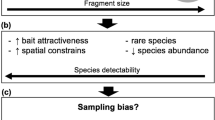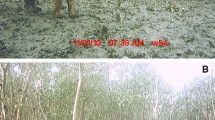Abstract
Track census is a widely used method for rapid faunal assessments, which assumes that differences in track count numbers mainly reflect differences in species abundance due to some biological factors. However, some methodological and climatic variables might affect results of track censuses. Here, we tested the effect of climatic variables, such as maximum temperature, humidity, wind speed or days since last rain, and methodological factors such as censusing day period, distance from transect to vegetation edge, substrate condition or observer, on the number of tracks of mammal carnivores and some of their potential prey detected in sandy substrates. We sampled 2 × 2 km2 located within the scrubland area of Doñana National Park (southwestern Spain) for carnivore and several potential prey tracks. Our results showed differences in the number of tracks detected between observers and a significant interaction between observers and the day period when censuses were carried out. Moreover, the variables increasing the quality of the substrate (higher environmental humidity, lower wind speed and days since last rain) not only led to a greater detection of carnivore tracks but, depending on the size of the species sampled other variables such as distance from transects to the vegetation border, also affected results. We recommend restricting sampling to certain fixed weather conditions when planning to monitor relative animal abundance from track censuses. When not possible, climatic or methodological variables should be included as covariates in analyses that try to test for the biological factors affecting wildlife abundance, taking into account that these variables, which affect the number of tracks detected could vary between years.




Similar content being viewed by others
References
Anderson DR (2001) The need to get the basics right in wildlife studies. Wildl Soc Bull 29:1294–1297
Austin MP (2002) Spatial prediction of species distribution: an interface between ecological theory and statistical modelling. Ecol Model 157:101–118
Balme GA, Hunter LTB, Slotow R (2009) Evaluating methods for counting cryptic carnivores. J Wildl Manag 73(3):433–441
Bayne E, Moses R, Boutin S (2005) Evaluation of winter tracking protocols as a method for monitoring mammals in the Alberta Biodiversity Monitoring Program. Rep Alta Biodivers Monit Progr, Vegreville, Alberta, Canada
Bayne EM, Boutin S et al (2008) Ecological factors influencing the spatial pattern of Canada lynx relative to its southern range edge in Alberta, Canada. Can J Zool Rev Can Zool 86(10):1189–1197
Bider JR (1968) Animal activity in uncontrolled terrestrial communities as determined by a sand transect technique. Ecol Monogr 38(3):269–308
Blaum N, Tietjen B et al (2009) Impact of livestock husbandry on small- and medium-sized carnivores in Kalahari savannah rangelands. J Wildl Manag 73(1):60–67
Buckland ST, Anderson DR, Burnham KP, Laake JL (1993) Distance sampling: estimating abundance of biological populations. Chapman and Hall, London, p 446
Caughley G, Sinclair ARE (1994) Wildlife ecology and management. Blackwell, Oxford
Crawley MJ (2005) Statistics: an introduction using R. Wiley, Chichester
Datta A, Anand MO, Naniwadekar R (2008) Empty forests: large carnivore and prey abundance in Namdapha National Park, north-east India. Biol Conserv 141(5):1429–1435
Engeman RM (2003) More on the need to get the basics right: population indices. Wildl Soc Bull 31:286–287
Evans J (2006) Observer error in identifying species using indirect signs: analysis of a river otter track survey technique. Thesis, Texas A&M University, College Station, TX, USA
Evans et al (2009) Determining observer reliability in counts of river otter tracks. J Wildl Manag 73:426–432
Funston PJ, Frank L et al (2010) Substrate and species constraints on the use of track incidences to estimate African large carnivore abundance. J Zool 281(1):56–65
Garel M, Bonenfant C, Hamann JL, Klein F, Gaillard JM (2010) Are abundance indices derived from spotlight counts reliable to monitor red deer populations? Wildl Biol 16(1)
Gibbs JP (2000) Monitoring populations. In: Boitani L, Fuller T (eds) Research techniques in animal ecology: controversies and consequences. Columbia Univ Press, New York, pp 213–247
Gruber B, Reineking B et al (2008) A new method for estimating visitation rates of cryptic animals via repeated surveys of indirect signs. J Appl Ecol 45(2):728–735
Gusset M, Burgener N (2005) Estimating larger carnivore numbers from track counts and measurements. Afr J Ecol 43(4):320–324
Hastie TJ, Tibshirani RJ (1990) Generalized additive models. Chapman & Hall, London
Hayward GD, Miquelle DG et al (2002) Monitoring Amur tiger populations: characteristics of track surveys in snow. Wildl Soc Bull 30(4):1150–1159
Hughes JJ, Ward D (1993) Predation risk and distance to cover affect foraging behaviour in Namib Desert gerbils. Anim Behav 46:1243–1245
Jennelle CS, Runge MC, MacKenzie DI (2002) The use of photographic rates to estimate densities of tigers and other cryptic mammals: a comment on misleading conclusions. Anim Conserv 5:119–120
Karanth KU, Nichols JD et al (2003) Science deficiency in conservation practice: the monitoring of tiger populations in India. Anim Conserv 6:141–146
Kufner MB (1986) Tamaño actividad, densidad relativa y preferencias de hábitat de los pequeños y medianos mamíferos de Doñana, como factores condicionantes de su tasa de predación. Thesis, Universidad Autónoma, Madrid, Spain
Kufner MB, Moreno YS (1989) Abundancia y amplitud de los desplazamientos de Apodemus sylvaticus en cuatro biotopos de Doñana que difieren en cobertura vegetal. Doñana, Acta Vertebrata 16:179–181
Liebenberg et al (2010) Practical tracking. Stackpole Books
Long et al 2008. Noninvasive survey methods for carnivores. Island Press
MacKenzie DI, Kendall WL (2002) How should detection probability be incorporated into estimates of relative abundance. Ecology 83:2387–2393
Mills LS, Citta J et al (2000) Estimating animal abundance using non-invasive DNA sampling: promise and pitfalls. Ecol Appl 10(1):283–294
Moreno S, Villafuerte R, Delibes M (1996) Cover is safe during the day but dangerous at night: the use of vegetation by European wild rabbits. Can J Zool 74:1656–1660
Newsome AE, Parer I, Catling PC (1989) Prolonged prey suppression by carnivores—predator-removal experiments. Oecologia 78:458–467
Nichols JD, Hines JE, Sauer JR, Fallon FW, Fallon JE, Heglund PJ (2000) A double-observer approach for estimating detection probability and abundance from counts. Auk 117:393–408
Norton PM (1990) How many leopards? A criticism of Martin and de Meulenaer’s population estimates for Africa. S Afr J Sci 86:218–220
Odonoghue M, Boutin S et al (1997) Numerical responses of coyotes and lynx to the snowshoe hare cycle. Oikos 80(1):150–162
Palomares F, Delibes M et al (2001) Spatial ecology of Iberian lynx and abundance of European rabbits in South western Spain. Wildl Monogr 148:1–36
Rosenstock SS, Anderson DR, Giesen KM, Leukering T, Carter MF (2002) Landbird counting techniques: current practices and an alternative. Auk 119:46–53
Russell JC, Hasler N et al (2009) Automatic track recognition of footprints for identifying cryptic species. Ecol 90:2007–2013
Sadlier LMJ, Webbon CC et al (2004) Methods of monitoring red foxes Vulpes vulpes and badgers Meles meles: are field signs the answer? Mamm Rev 34:–7598
Sargeant GA, Sovada MA et al (2005) Markov chain Monte Carlo estimation of species distributions: a case study of the swift fox in western Kansas. J Wildl Manag 69:483–497
Shapira I, Sultan H et al (2008) Agricultural farming alters predator–prey interactions in nearby natural habitats. Anim Conserv 11(1):1–8
Short J, Turner B, Risbey DA, Carnamah R (1997) Control of feral cats for nature conservation: II. Population reduction by poisoning. Wildl Res 24:703–714
Silveira L, Jácomo ATA, Diniz-Filho JAF (2003) Camera trap, line transect census and track surveys: a comparative evaluation. Biol Conserv 114:351–355
Smallwood KS, Fitzhugh EL (1995) A track count for estimating mountain lion Felis concolor californica population trend. Biol Conserv 71:251–259
Stander PE (1998) Spoor counts as indices of large carnivore populations: the relationship between spoor frequency, sampling effort and true density. J Appl Ecol 35:378–385
Stephenson RO (1986) Development of lynx population estimation techniques. Alaska Department of Fish and Game, Project W-22-2, W-22-3, W-22-4, and W-22-5, Res. Final Report, 84 pp
Thompson ID, Davidson IJ et al (1989) Use of track transects to measure the relative occurrence of some boreal mammals in uncut forest and regenerations stands. Can J Zool 67:1816–1823
Thompson WL, White GC, Gowan C (1998) Monitoring vertebrate populations. Academic Press, San Diego, CA, USA
Van Dyke FG, Brocke RH, Shaw HG (1986) Use of road track counts as indexes of mountain lion presence. J Wildl Manag 50(1):102–109
Watts CH, Thornburrow D et al (2008) Tracking tunnels: a novel method for detecting a threatened New Zealand giant weta (Orthoptera: Anostostomatidae). N Z J Ecol 31:92–97
Williams BK, Nichols JD, Conroy MJ (2002) Analysis and management of animal populations: modeling, estimation, and decision making. Academic Press, San Diego, CA, USA, pp 1–1040
Wilson GJ, Delahay RJ (2001) A review of methods to estimate the abundance of terrestrial carnivores using field signs and observation. Wildl Res 28(2):151–164
Yoccuz NG, Nichols JD, Boulinier T (2001) Monitoring of biological diversity in space and time. Trends Ecol Evol 16:446–453
Zaumyslova OYu (2000) Long term population-dynamics of ungulates in the Sikhote-Alin Reserve from winter transect count data. In: Astafiev AA (ed) Analysis of long-term monitoring data of nature components in nature reserves in the Russian Far East. USAID, Dalnauka, Vladivostok, pp 70–79
Zielinski WJ, Schlexer FV (2009) Inter-observer variation in identifying mammals from their tracks at enclosed track plate stations. Northwest Sci 83(4):299–307
Zielinski WJ, Kucera TE, Barrett RH (1995) American marten, fisher, lynx, and wolverine: survey methods for their detection. USDA forest service, Pacific Southwest Research Station general technical report PSW-GTR-157, Albany, CA
Acknowledgments
This research was funded by the projects CGL2004-00346/BOS (Spanish Ministry of Education and Science) and 17/2005 (Spanish Ministry of the Environment; National Parks Research Program). Land-Rover España lent us two vehicles for this work. We are very grateful especially to J.C. Rivilla for their assistance during fieldwork. C. Soto was also supported by a JAE-Predoc grant from the CSIC.
Author information
Authors and Affiliations
Corresponding author
Additional information
Communicated by P. Acevedo
Rights and permissions
About this article
Cite this article
Soto Navarro, C.Á., Desniça, S. & Palomares Fernández, F. Nonbiological factors affecting track censuses: implications for sampling design and reliability. Eur J Wildl Res 58, 117–126 (2012). https://doi.org/10.1007/s10344-011-0551-9
Received:
Revised:
Accepted:
Published:
Issue Date:
DOI: https://doi.org/10.1007/s10344-011-0551-9




